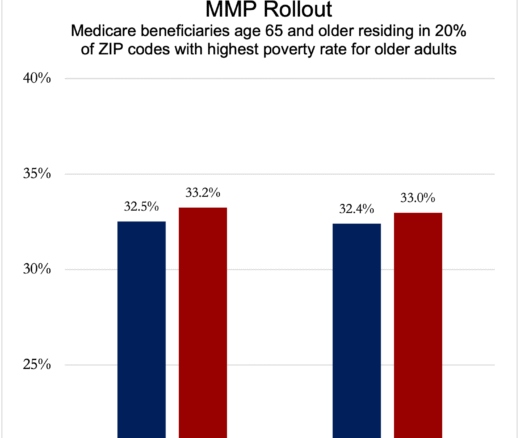
Acupuncture Could Fix America’s Chronic Pain Crisis–So Why Can’t Patients Get It?
A Proven, Low-Risk Treatment Is Backed by Major Studies and Patient Demand, Yet Medicare and Insurers Still Make It Hard To Use
Brief

Since it launched in 2015, Medicare’s Skilled Nursing Facility Value-Based Purchasing Program has failed to reduce hospital readmissions as intended. Fortunately, it does not increase deaths, nor does it appear to delay needed rehospitalizations. The program’s new performance measures and incentives could help it achieve its goals.
LDI Senior Fellows Robert Burke, Atul Gupta, LDI Executive Director Rachel M. Werner, and colleagues, including Franya Hutchins and Syama Patel from Penn, assessed the impact so far of Medicare’s value-based payment program for skilled nursing facilities.
Their study is the most extensive analysis to date and the first to use beneficiary-level data. “The program is not currently working,” Burke said. “However, upcoming changes to the structure and measures offer an opportunity to test if it’s effective for different patient care outcomes.”
All skilled nursing facilities certified by the Centers for Medicare & Medicaid Services (CMS) must participate in this Medicare initiative. The program, established through bipartisan legislation, is the largest-ever pay-for-performance initiative for this type of care. It seeks to reduce 30-day hospital readmission rates among traditional Medicare beneficiaries. When the program began, 20% of these patients were discharged to a skilled nursing facility after hospitalization, and of those, 25% were readmitted within 30 days.

The program gives facilities bonuses or penalties of about 2% of their per-patient payments, based on either readmission rates compared to peer facilities
or improvement in their own rates. A hospital-focused program reduced 30-day readmissions, suggesting the strategy would work for skilled nursing facilities.
Hospital readmissions within 30 days of discharge to a skilled nursing facility were not reduced by the Value-Based Purchasing Program (Figure 1).
The program did not have adverse effects either: It did not increase 30-day mortality or change patients’ return home within 100 days of hospital discharge. A lack of change in length of stay suggested the facilities did not delay readmissions to avoid penalties. The researchers suggest three main reasons for the program’s failure.
First, nursing homes may not have the funds and trained staff for the quality improvement work needed to significantly reduce hospital readmissions. Burke and colleagues’ earlier study showed that facilities already struggling with performance metrics had difficulty avoiding penalties. Their findings indicated that the program may inadvertently worsen care disparities by race, ethnicity, and income. Second, the size of the incentives might be insufficient. Most revenue for skilled nursing facilities comes from Medicaid payments for long-term stays, weakening the impact of incentives from Medicare.
In addition, facility finances are often opaque, which may hinder CMS’s ability to determine the size of incentives that would drive meaningful change. Third, although the study used 10 years of data, rewards and penalties started only in 2019, and some program elements were suspended during the COVID-19 pandemic. More time may be needed to reveal the full impact of the program.
CMS is changing the Skilled Nursing Facility Value-Based Purchasing Program, adding rewards for excellent care for people dually eligible for Medicare and Medicaid, and introducing measures for infections, falls, function at discharge, nurse staffing, and turnover. The agency will also switch from measuring 30-day readmissions to potentially preventable readmissions.
“This could be an opportunity for lower-performing skilled nursing facilities,” Burke said. “Some measures, such as infections, might be easier for them to control.
But improving staffing and turnover requires hiring, and it’s not clear the incentives will be large enough to cover that.”
The authors hope that CMS uses their study’s findings to improve the value-based payment program. CMS could consider larger incentives or financial risks for skilled nursing facilities, Burke said: “Two-thirds of facilities had funding withheld through penalties, so CMS could adjust penalties and incentives without additional costs.”
For additional evidence on how to improve the program, Burke and colleagues are studying the size and variability of bonuses and penalties. They are also
identifying factors associated with success by visiting some of the 12% of facilities that improved under the program.
The researchers used MedPAR data on nearly 17.4 million skilled nursing facility stays from 2011 to 2021 among Medicare fee-for-service beneficiaries and applied methods that allow conclusions about the direct impact of the Skilled Nursing Facility Value-Based Purchasing Program on patient outcomes.
They compared facilities most likely to be affected by the program (because they provided the most days of post-acute care paid by Medicare) to facilities with the fewest care days. This control group experienced the same external context, including the COVID-19 pandemic, as the high-serving facilities.
The program covers only traditional Medicare beneficiaries. Its impact on the 33 million people with Medicare Advantage is unknown. The study’s readmission rates may not precisely match CMS rates because the exact CMS calculation method is unknown.
Source Publication: Burke, R.E., Hutchins, F., Heintz, J., Appel, S., Norman, J., Patel, S., Gupta, A., Rose, L., Werner, R.M. June 2025. “Skilled Nursing Facility Value-Based Purchasing Failed To Achieve Hospital Readmission Reductions And Other Targets.” Health Affairs. https://doi:10.1377/hlthaff.2024.01402

A Proven, Low-Risk Treatment Is Backed by Major Studies and Patient Demand, Yet Medicare and Insurers Still Make It Hard To Use

Chart of the Day: Medicare-Medicaid Plans—Created to Streamline Care for Dually Eligible Individuals—Failed to Increase Medicaid Participation in High-Poverty Communities
Research Brief: Shorter Stays in Skilled Nursing Facilities and Less Home Health Didn’t Lead to Worse Outcomes, Pointing to Opportunities for Traditional Medicare

How Threatened Reproductive Rights Pushed More Pennsylvanians Toward Sterilization

Abortion Restrictions Can Backfire, Pushing Families to End Pregnancies

They Reduce Coverage, Not Costs, History Shows. Smarter Incentives Would Encourage the Private Sector